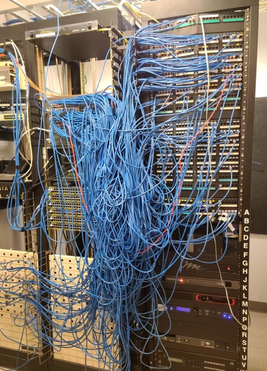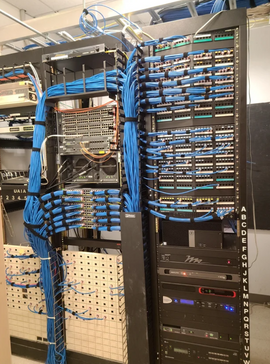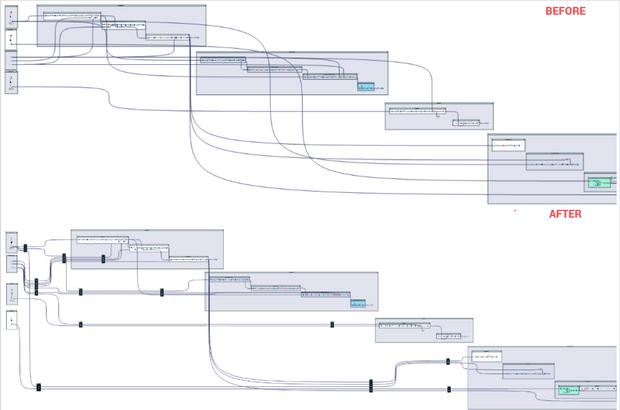Alteryx Designer Desktop Ideas
Share your Designer Desktop product ideas - we're listening!Submitting an Idea?
Be sure to review our Idea Submission Guidelines for more information!
Submission Guidelines- Community
- :
- Community
- :
- Participate
- :
- Ideas
- :
- Designer Desktop : Beliebte Ideen
Featured Ideas
Hello,
After used the new "Image Recognition Tool" a few days, I think you could improve it :
> by adding the dimensional constraints in front of each of the pre-trained models,
> by adding a true tool to divide the training data correctly (in order to have an equivalent number of images for each of the labels)
> at least, allow the tool to use black & white images (I wanted to test it on the MNIST, but the tool tells me that it necessarily needs RGB images) ?
Question : do you in the future allow the user to choose between CPU or GPU usage ?
In any case, thank you again for this new tool, it is certainly perfectible, but very simple to use, and I sincerely think that it will allow a greater number of people to understand the many use cases made possible thanks to image recognition.
Thank you again
Kévin VANCAPPEL (France ;-))
Thank you again.
Kévin VANCAPPEL
We can Cache and Run Workflow for individual input tools now. Why not let there be a default option to just do it automatically? Or a Run & Cache feature next to Run?
Problem:
In large Alteryx workflows, renaming a column using a Select tool (or similar) causes downstream tools like Formula, Filter, Join, Sort, etc., to break or throw errors if they reference the old column name.
This means every time a column is renamed, I have to manually go through every tool that used the old name and update it - which is tedious, time-consuming, and error-prone.
Proposed Enhancement:
Add a feature to automatically propagate field name changes across all tools in the workflow that reference the renamed field.
This could work similarly to how modern IDEs allow you to "rename variable" across an entire codebase, or how refactoring works in platforms like Tableau Prep or Power BI.
Benefits:
Saves time when making structural changes to data schemas.
Reduces human error caused by missing updates in some tools.
Makes workflows more scalable and easier to maintain.
Improves usability and development speed for all users, especially in large or collaborative workflows.
Block-Until-Done could be improved through adding time delay option settings between steps 1,2 and 3. An Excel workbook, for example, must be opened and closed before it can be reread or multiple tabs appended which takes time for a computer to process. Often a workaround or custom macro must be used to account for this time delay. A time delay feature directly in the tool would enable a user to customize the delay period between steps and allow for functions external to Alteryx to complete before next step is taken without macros or workarounds. If no option(s) is selected, default parameters would apply.
We have a feature to limit the number of records, and I thought why not have a column limit as well?
Columns take up a lot of space and processing, the more columns we have the more it slows down. So if we can declare it at the start to import the first 20 columns always, it’ll ensure that any new or unwanted columns in Excel will be avoided.
Hello,
Right now you can write a file into sharepoint. However, sometimes, you just want to upload a file. There is already the ability to download (for Sharepoint input). I would like the same for uploading a file (based on an path or workflow dependancies).
Best regards,
Simon
When the name of a field is changed early in a workflow, all corresponding tools that use the renamed field should have the option to auto update the field name. This way I don't have to manully update the name of each effected field.
Search Box for Tools like Formula Tool where a drop down list of all columns is present to choose from the list. It might take quite a while to search for a specific column in a Formula tool when there is hundreds of columns in a data stream. This is quite an important case when we work with raw columns directly from an SAP extractor.
I would like the parse tools (regex, split to columns...) to by defualt, not point at any column.
The parse tools need to be pointed at a column, however they by defualt configure them selves to point at the first column. Every time I use them, I enter the other configuration options, such as a regular expression, then hit run. After hitting run, my output column will be populated with only null values yet I will recieve no error.
The reason for this, is 100% EBKAC (error between keyboard and chair), as I have forgotton to point the tool to the correct column, and instead its looking at the defualt (first column)
If the defualt option didnt exist, or was blank, the tool would then error telling me to think about what im doing and point the tool to the correct column.
I believe this change in the tools defualt behaviour would save hours of debug time, wondering why my regex statment isnt working, when in actual fact im just looking at the wrong column.
Hi
Currently the date time now input outputs data only in string format, it could be useful if there was an option to output the data in date or date time format.
Hi everyone! I have been trying to find a way to do this without creating a new idea, but I have decided to make it an official 'Idea' to see if there is anyone else that might appreciate a feature like this (or has found there own way to do it!)
Do your workflows look like this...
but you wish they could look like this?
Well... they can with your help!
Okay, I might be crazy...but its worth a shot.
While I understand this is an extremely niche issue, in my experience, it can become very difficult to trace the data through unmanaged lines in large workflows. I think it will be great to cable manage canvas lines so workflows are easier to follow. Heck, while I am already at it, I think it we should all start calling these canvas lines cables... They don't carry electricity, but they sure do carry data!
Here is an example I created in Alteryx using select tools and containers:
Our team was very excited with the deployment of Alteryx One Enterprise Edition, but had to scratch our head on why DateTimeNow and Data Cleansing is available to Full Users but not Basic Users. What had us scratching our heads further, is Designer Cloud for Basic Users have DateTimeNow and Data Cleansing.
Hopefully the community and Alteryx can agree these are basic tools for everyone!
Alteryx Help References:
Alteryx>Alteryx One Editions>User Roles>Basic User Role>Basic User Capabilities
Alteryx>Alteryx One Editions>User Roles>Full User Role>Full User Capabilities
Alteryx>Alteryx One Platform Editions>Enterprise Edition>Enterprise Edition Capabilities
In the 20 years of my career I have built many automations using many tools. Alteryx is one of the best but lacks a key function that many others have. The File Browse Tool and the Folder Browse tool should be able to be configured with default values.
There should be an option under the File Specification that says "Default Location". When the user clicks browse button in the Analytical Interface it should default to opening that location ( eg.. \\ShareDrive\Reports\Finance\ ). If this location in inaccessible by the user or Account running the job then either an error should be thrown and the flow stopped or a default location open as in 2024.2
Users have requested this as when you have a large network browsing to the file you need can be slow and cumbersome. Ideally we should be able set the default location in the Designer to the folder where the file they want "most likely" is. Saving the user time and effort. This same concept applies to Folder Browse.
The funny part about this is when you ask Alteryx Co-Pilot (or ChatGPT, or Microsoft Co-Pilot) how to do this. Even it figures this was a option that exists.
Similar to the setting that you have in many individual tools (join, append, select, et al) where you can go to options and choose to "forget missing fields" it would be nice where you could go to options for the entire flow and "forget missing fields".
This would remove the headache that you have with large flows where you make a change(s) then have to go back through each and every tool to "forget" within that tool. Yes you could still do it individually, but if you chose, you could also do it universally for the entire flow all at once to all the 'missing fields'.
Hello,
The Data source window allow severla kind of connections like quick connect, ODBC, etc. But the order is not the same and this is confusing :
Best regards,
Simon
Currently, the Alteryx Designer canvas can only be extended to the right and downward. This restriction makes organizing complex workflows more difficult, especially when trying to insert new logic upstream or manage spatial layout more naturally. It forces users to design in a constrained directional flow, limiting flexibility and sometimes resulting in awkwardly stretched workflows.
Proposed Solution:
Introduce an Infinite Canvas option that allows users to pan and place tools in any direction: left, right, up, or down. This would:
- Enable more natural workflow layout and organization
- Allow insertion of tools before existing logic without major rearrangement
- Improve visibility and navigation for large, complex workflows
- Mirror the functionality of modern visual tools like Figma, Miro, or Lucidchart
Bonus Suggestion:
Include a toggle or setting in Preferences to enable Infinite Canvas mode, so users can choose their preferred design behavior.
Impact:
Improved usability, better layout control, reduced time spent reformatting workflows, and a more modern, flexible design experience for Alteryx users at all levels.
Currently if I have a connection between two tools as per the example below:
I can drag and drop a new tool on the connection between these tools to add it in:
And designer updates the connections nicely, however if I select multiple tools and try and collectively drop them inbetween, on a connection then it won't allow me to do this, and will move the connection out of the way so it doesn't cause an overlap.
Therefore as a QoL improvement it would be great if there was a multi-drop option on connections between tools.
A client just asked me if there was an easy way to convert regular Containers to Control Containers - unfortunately we have to delete the old container and readd the tools into the new Control Container.
What if we could just right click on the regular Container and say "Convert to Control Container"? Or even vice versa?!
Whenever we upload a workflow in the Gallery, we have to manually unselect, one by one, all the workflow assets in order to avoid them being packaged, because we use absolute UNC paths everywhere: if an asset is packaged, there might be errors due to relative paths
It would save time to have the option to either "Select all" or "Unselect all" in the interface shown in the attachment (Capture.png)
Hello,
What about a new tool to deal with file actions, such as deleting, renaming, moving, etc ? Today, we do that with cmd, not the easiest way to do. I have developed a tool on Amphi that gives a good idea of what we could have on Alteryx
Here the result :
That can help with temporary, useless files and probably other use cases.
Best regards,
Simon
Hello,
A very simple idea :
as of today, there are dedicated connectors to Sharepoint, OneDrive and Azure Data Lake.
For all these connectors, the files we can read are limited, very limited : xlsx, csv, yxdb
The location of the storage is not relevant, we should be able to read any already supported file on these locations (like parquet or shp or whatever).
Best regards,
Simon
- New Idea 377
- Accepting Votes 1.784
- Comments Requested 21
- Under Review 178
- Accepted 47
- Ongoing 7
- Coming Soon 13
- Implemented 550
- Not Planned 107
- Revisit 56
- Partner Dependent 3
- Inactive 674
-
Admin Settings
22 -
AMP Engine
27 -
API
11 -
API SDK
228 -
Category Address
13 -
Category Apps
114 -
Category Behavior Analysis
5 -
Category Calgary
21 -
Category Connectors
252 -
Category Data Investigation
79 -
Category Demographic Analysis
3 -
Category Developer
217 -
Category Documentation
82 -
Category In Database
215 -
Category Input Output
655 -
Category Interface
246 -
Category Join
108 -
Category Machine Learning
3 -
Category Macros
155 -
Category Parse
78 -
Category Predictive
79 -
Category Preparation
402 -
Category Prescriptive
2 -
Category Reporting
204 -
Category Spatial
83 -
Category Text Mining
23 -
Category Time Series
24 -
Category Transform
92 -
Configuration
1 -
Content
2 -
Data Connectors
982 -
Data Products
4 -
Desktop Experience
1.605 -
Documentation
64 -
Engine
134 -
Enhancement
407 -
Event
1 -
Feature Request
218 -
General
307 -
General Suggestion
8 -
Insights Dataset
2 -
Installation
26 -
Licenses and Activation
15 -
Licensing
15 -
Localization
8 -
Location Intelligence
82 -
Machine Learning
13 -
My Alteryx
1 -
New Request
226 -
New Tool
32 -
Permissions
1 -
Runtime
28 -
Scheduler
26 -
SDK
10 -
Setup & Configuration
58 -
Tool Improvement
210 -
User Experience Design
165 -
User Settings
86 -
UX
227 -
XML
7
- « Vorherige
- Nächste »
- abacon auf: DateTimeNow and Data Cleansing tools to be conside...
-
TonyaS auf: Alteryx Needs to Test Shared Server Inputs/Timeout...
-
TheOC auf: Date time now input (date/date time output field t...
- EKasminsky auf: Limit Number of Columns for Excel Inputs
- Linas auf: Search feature on join tool
-
MikeA auf: Smarter & Less Intrusive Update Notifications — Re...
- GMG0241 auf: Select Tool - Bulk change type to forced
-
Carlithian auf: Allow a default location when using the File and F...
- jmgross72 auf: Interface Tool to Update Workflow Constants
-
pilsworth-bulie
n-com auf: Select/Unselect all for Manage workflow assets
| Benutzer | Anzahl |
|---|---|
| 32 | |
| 6 | |
| 5 | |
| 3 | |
| 3 |










